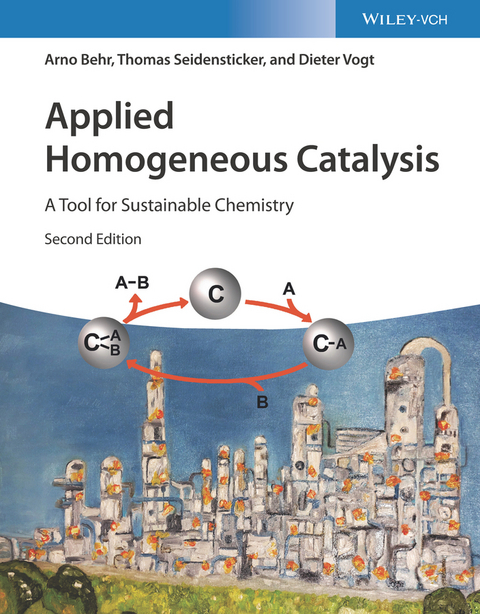
Applied Homogeneous Catalysis
Wiley-VCH (Verlag)
978-3-527-35111-4 (ISBN)
- Noch nicht erschienen (ca. Mai 2025)
- Versandkostenfrei innerhalb Deutschlands
- Auch auf Rechnung
- Verfügbarkeit in der Filiale vor Ort prüfen
- Artikel merken
Arno Behr was Professor of Technical Chemistry at the Technical University Dortmund, Germany. He studied chemistry at the RWTH Aachen University, Germany, where he obtained his doctor and habilitation degrees. After 10 years in chemical industry as department head in chemical process engineering, he changed 1996 to TU Dortmund University, where he led the Chair of Industrial Chemistry until his retirement in 2017. He published 300 publications in scientific journals - especially in the field of homogeneous catalysis and its technical applications, as well as 10 books. Thomas Seidensticker leads a junior research group at TU Dortmund University, Germany. He studied chemistry at TU Dortmund University, where he completed his Ph.D. in 2016 under the supervision of Prof. Dr. Arno Behr. Since 2017, he has been working on his independent career with Prof. Dr. Dieter Vogt. His research is dedicated to sustainable process design for homogeneous catalysts, including the development of innovative recycling methods and the conversion of renewable resources. Dieter Vogt is head of the Chair of Industrial Chemistry at the TU Dortmund University, Germany, since 2017. He obtained his doctor and habilitation degrees with Wilhelm Keim at RWTH Aachen University, Germany. From 1999 he led the Chair of Inorganic and Coordination Chemistry at Eindhoven University of Technology (The Netherlands) and from 2012 the Chair of Industrial Chemistry at the School of Chemistry of Edinburgh (UK). His main research interests are in homogeneous transition metal catalysis, ligand and catalyst design, renewables and process development in continuously operated miniplants.
FOREWORD
PREFACE
ABBREVIATIONS
INTRODUCTION:
Adhering to the 12 Principles of Green Chemistry: How does homogeneous catalysis contribute? *NEW*
PART I: CHEMICAL BASICS
1. What actually is catalysis? Definition, options, and examples
2. Homogeneous transition metal catalysis: A young science
3. What is the economic importance? Industrial homogeneous catalysis
4. Selectivity, STY, TON, TOF and co.: Definitions of important terms
5. Basics of organometallic chemistry: Bonds, elemental steps, and mechanisms
6. The "captains" of homogeneous catalysis: Transition metal complexes
7. The "mates" of homogeneous catalysis: The complex ligands
8. The reaction medium: The solvents
9. The "special case": Enantioselective catalysis
10. When does a chemical reaction run? Thermodynamics of homogeneous catalysis
11. How does the reaction proceed? Kinetics of homogeneous catalysis
12. Can we see into homogeneous catalysis? Overview on spectroscopic methods
PART II: PROCESS ENGINEERING ASPECTS
13. Where does catalysis occur? Reactor types
14. Is my catalyst economical? Overview on catalyst recycling methods
15. The removal of volatile products: Thermal separation
16. From homogeneous to heterogeneous: Immobilisation on solid supports
17. The smart way of catalyst separation: Liquid-liquid multiphase systems
18. Clever enhancements: Thermomorphic liquid systems
19. The fast way to optimum results: Combinatorial chemistry and high throughput screening
20. From laboratory to production: Process development in miniplant
PART III: REACTION TYPES
21. A guide through the jungle: Overview on C-C bonding reactions
22. The industrial way to aldehydes and alcohols: Hydroformylations
23. The versatile insertions of carbon monoxide: Carbonylations
24. The conversion of unsaturated aliphatics into chains or rings: Oligomerisation and cyclooligomerisation
25. A change-your-partners dance: Metathesis
26. The assembly of macromolecules: Polymerisations
27. The construction of C8 and C10 chains: Telomerisations
28. New name reactions: Carbon-carbon coupling with aromatics
29. C-H bond formation: Hydrogenations
30. Formation of C-O bonds: Oxidations
31. Formation of C-N bonds: Aminations
32. Migration of double bonds and rearrangement of the carbon backbone: Isomerisations
33. Multiple synthesis steps in one pot: Tandem reactions
PART IV: ASSOCIATED CATALYSIS
34. Between Homogeneous and Heterogeneous Catalysis: Nanocatalysis
35. Other ways of activation: Electro-/ sono-/ photocatalysis / microwave / mechanocatalysis
36. The homogeneous way without metals: Organocatalysis
PART V: NEW RESOURCES
37. Acquisitions of new feedstocks: Alkane activations
38. The activation of an "inactive" molecule: Reactions with carbon dioxide
39. The grip in the air: Homogeneous activation of nitrogen
40. The use of waste: Recycling of polymers
41. Using nature's treasures: Homogeneous catalysis with renewables
42. A look ahead: Future challenges of homogeneous catalysis
ANSWERS TO PROBLEMS
| Erscheinungsdatum | 12.04.2024 |
|---|---|
| Verlagsort | Berlin |
| Sprache | englisch |
| Maße | 216 x 276 mm |
| Themenwelt | Naturwissenschaften ► Chemie ► Physikalische Chemie |
| Schlagworte | catalysis • chemical engineering • Chemie • Chemische Verfahrenstechnik • Chemistry • Industrial Chemistry • Katalyse • Nachhaltige u. Grüne Chemie • Organic Chemistry • Organische Chemie • Process Engineering • Prozesssteuerung • Sustainable Chemistry & Green Chemistry • Technische u. Industrielle Chemie |
| ISBN-10 | 3-527-35111-6 / 3527351116 |
| ISBN-13 | 978-3-527-35111-4 / 9783527351114 |
| Zustand | Neuware |
| Informationen gemäß Produktsicherheitsverordnung (GPSR) | |
| Haben Sie eine Frage zum Produkt? |
aus dem Bereich


